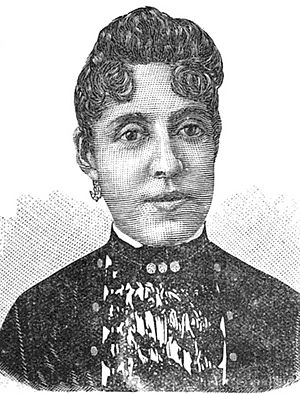Amelia Tilghman facts for kids
Amelia Louise Tilghman (pronounced "TILL man") was an amazing woman who lived from 1856 to 1931. She was a talented pianist, a dedicated teacher, and an important activist. She made history by starting the very first music magazine for African Americans, called The Musical Messenger. It was published from 1886 to 1891.
Contents
Amelia's Early Life and Talents
Amelia Tilghman grew up in Washington, D.C.. She was the oldest daughter of Margaret Ann Reynolds and Henry Hyland Tilgman. Her family was part of a free Black community, which meant Amelia had a comfortable upbringing. She was lucky to be part of the Black middle class in Washington, D.C.
Her family was very involved in their church. This helped Amelia develop her natural musical gifts. Her parents were very proud of her musical abilities. Amelia showed great talent for singing and playing the piano from a young age.
A Voice That Impressed Many
Amelia's beautiful voice impressed many people. One important person was Bishop Daniel Alexander Payne. He was a leader at the African Methodist Episcopal Church (A.M.E.) in Washington. He was so amazed by her voice that he reportedly said, "That child's parents had better spend a hundred dollars on her voice now than leave her a fortune when they die." This shows how special Amelia's talent was. We don't know much about her very early music lessons.
Education and Teaching Career
When Amelia became an adult, she went to the Normal School at Howard University. She graduated in 1870. Right after graduating, Amelia got a full-time job. She became a teacher in the Black public schools in Georgetown, Washington, D.C., in 1870.
After teaching for fourteen years, she moved to Boston. There, she studied music teaching methods with Samuel Jamieson. She attended the Boston Conservatory of Music. However, she did not finish with a degree from the conservatory.
A Star on the Piano
Besides teaching, Amelia also had a career as a pianist. She performed at Steinway Hall in Manhattan, New York, in 1880. A reviewer described her as "a musical star of the first magnitude." This means she was considered a top musician.
The next year, she was invited to be a soloist at Saengerfest. This was a music festival held at the Grand Opera House in Louisville, Kentucky. There, she heard a choral work called Esther, the Beautiful Queen by William Batchelder Bradbury. She loved it so much that she decided to put on her own production of the piece. She organized, directed, and starred in the show in Washington, D.C. The performance happened on Thanksgiving in 1881. It was called "a grand success." It proved that Black musicians had great talent. They just needed good training to create truly artistic performances.
Move to Alabama and Journalism
In early 1886, Amelia Tilghman moved to Montgomery, Alabama. We don't know exactly why she moved. She took a job teaching in the public schools there. A journalist wrote in 1893 about her arrival. They said that before Amelia came, "there were no colored pianists in Montgomery." Also, you wouldn't hear artistic music being played in Black homes. But after she arrived, you could hear it "in almost every two or three squares." This shows the big impact she had. In her first year in Montgomery, Amelia organized a recital for her students. It was held in a local Congregational Church.
Founding The Musical Messenger
In Montgomery, Amelia Tilghman started something very important. She founded the first music magazine for African Americans. It was a monthly publication called The Musical Messenger. Getting into journalism was not easy for her. At that time, men mostly ran the field. Women often faced prejudice for many years.
The magazine's motto was "the highest moral, social and intellectual interest of the people." The two issues that still exist today are both from 1889. They focused on teaching readers about music history. For example, they included a biography of the composer Haydn. They also covered church choir music. And they shared the names and work of African-American composers. The Philadelphia Tribune newspaper wrote about her magazine. They said, "That the race stands sadly in need of such a journal should be freely admitted." They hoped Amelia's efforts would be supported.
Return to Washington, D.C.
Amelia Tilghman moved back to Washington, D.C., permanently in 1888. She went back to help care for her mother, who was very ill. In Washington, she hired another musician and teacher, Lucinda Bragg Adams, to be an associate editor for The Musical Messenger. Even though the magazine was praised, it did not make a lot of money.
After 1891, Amelia stopped publishing the magazine. She decided to focus her energy on teaching again. She passed away in 1931.


